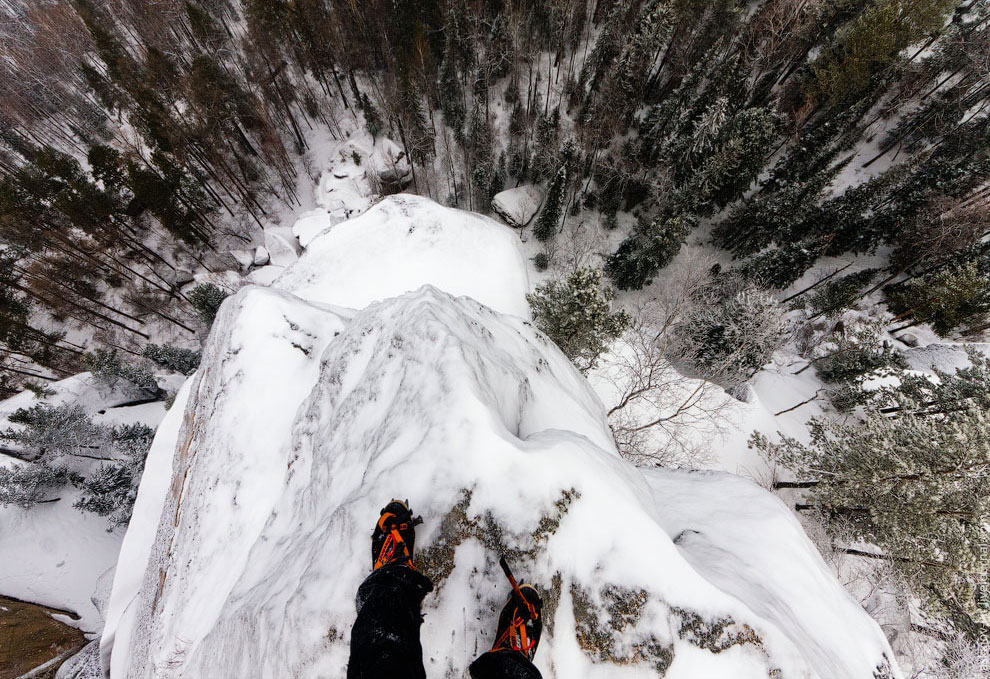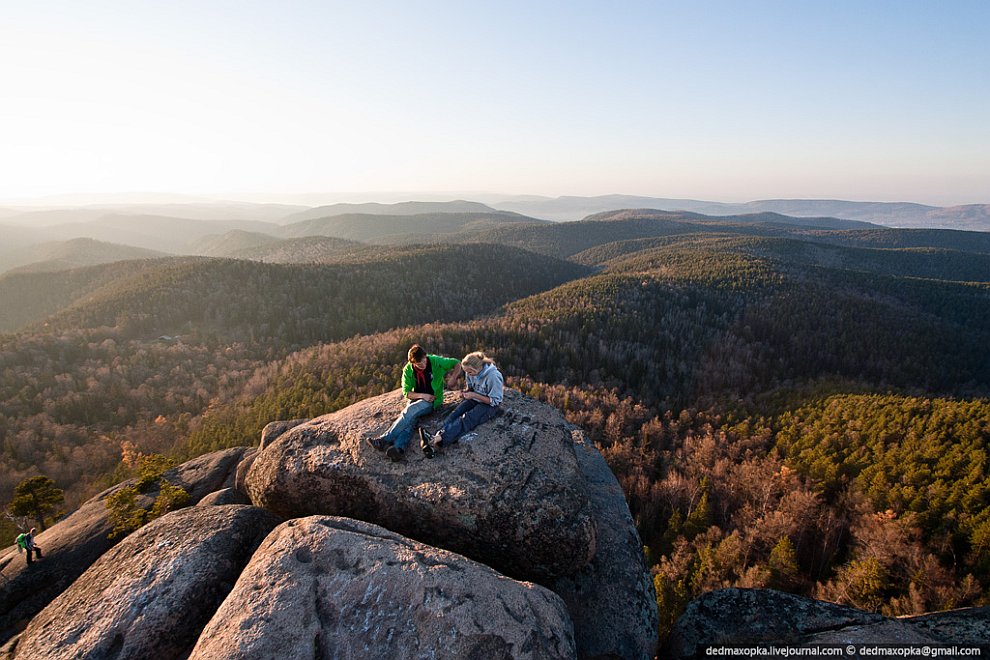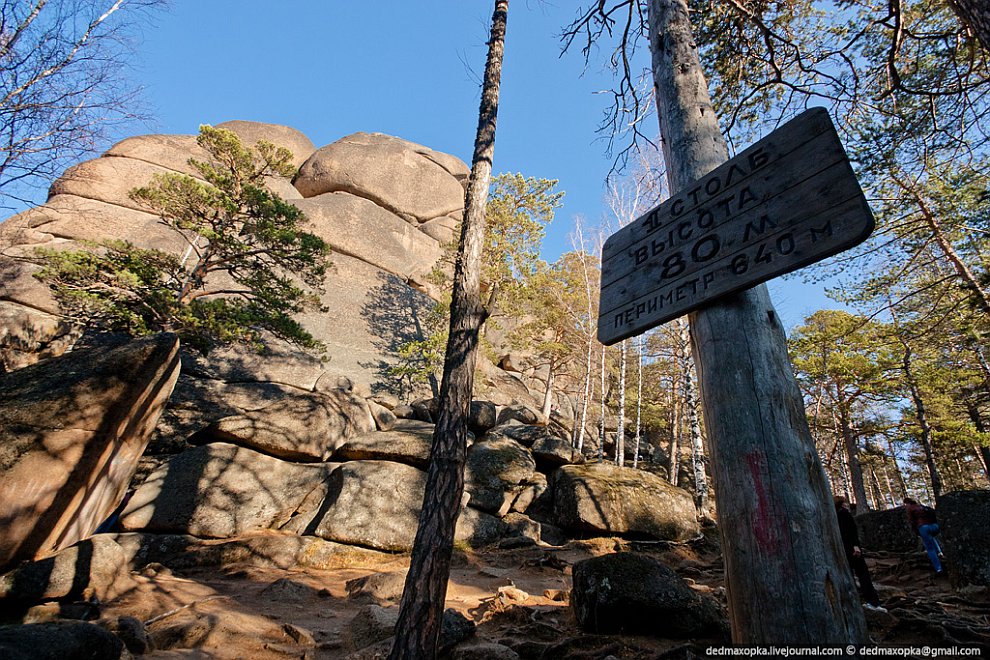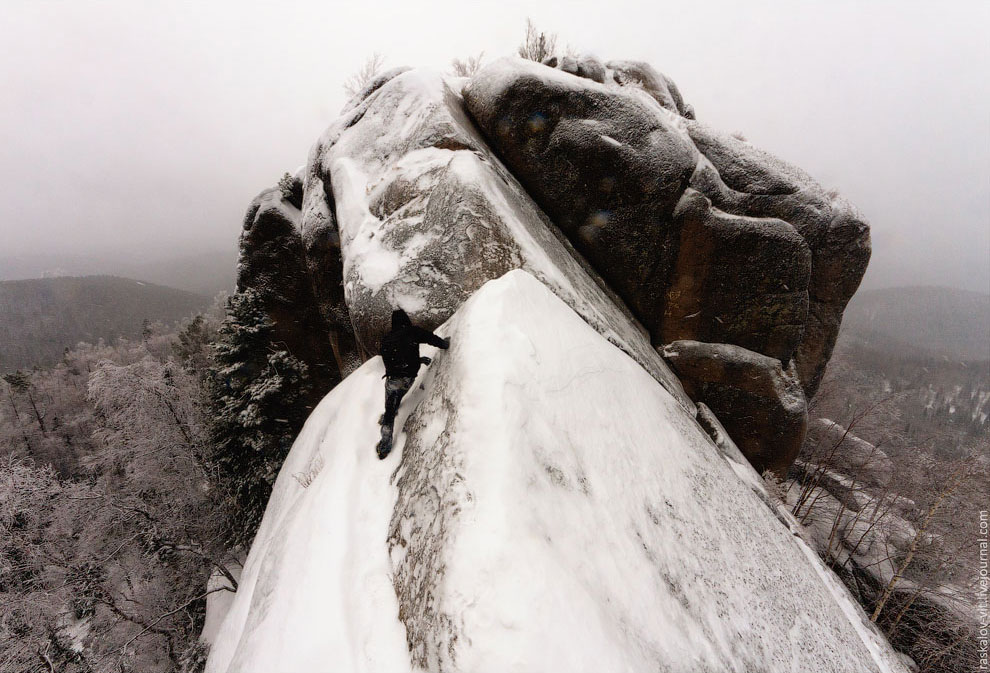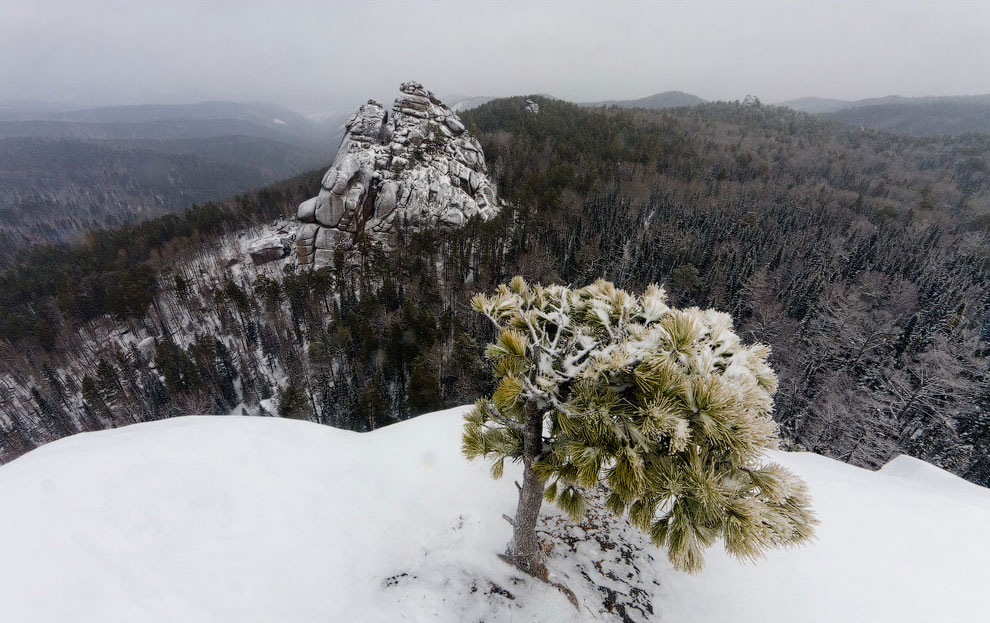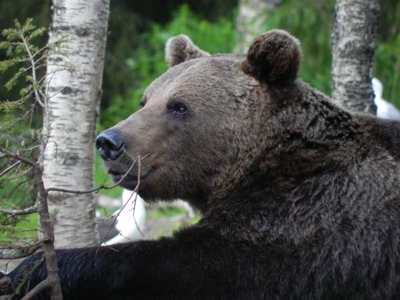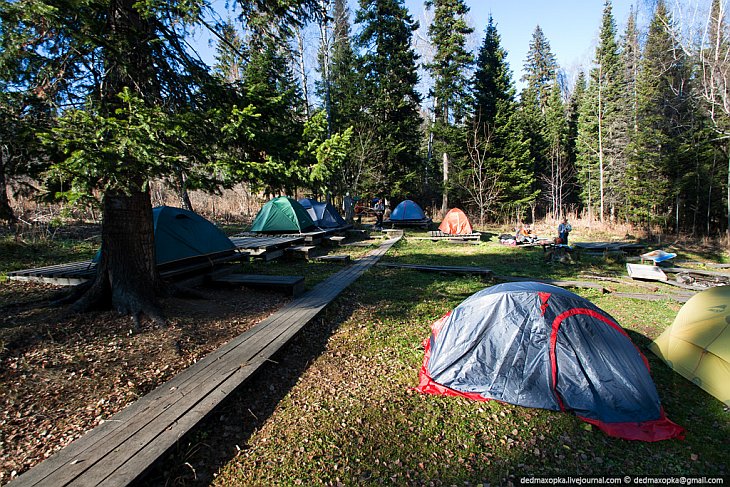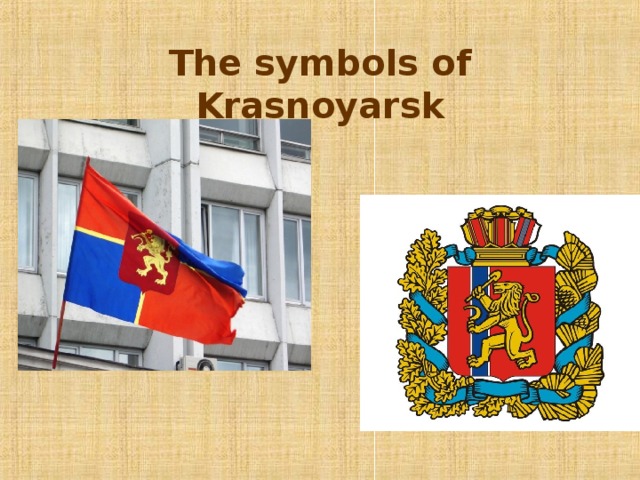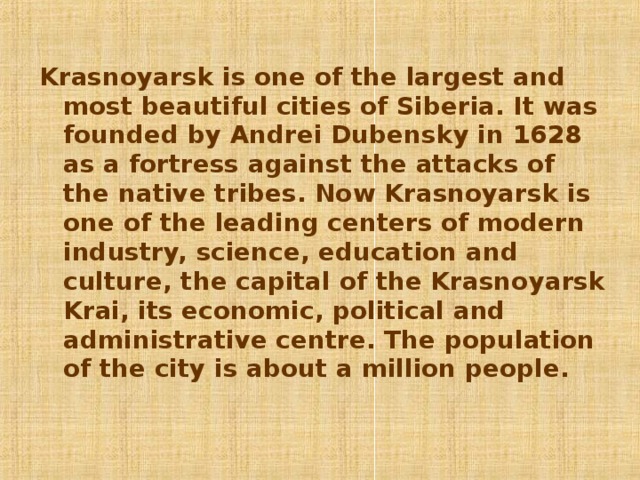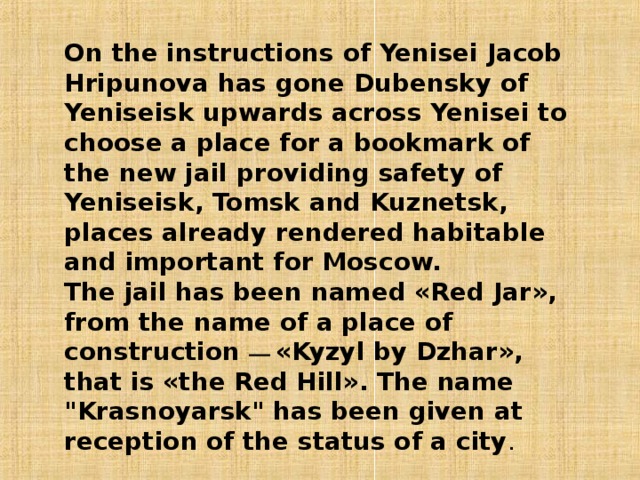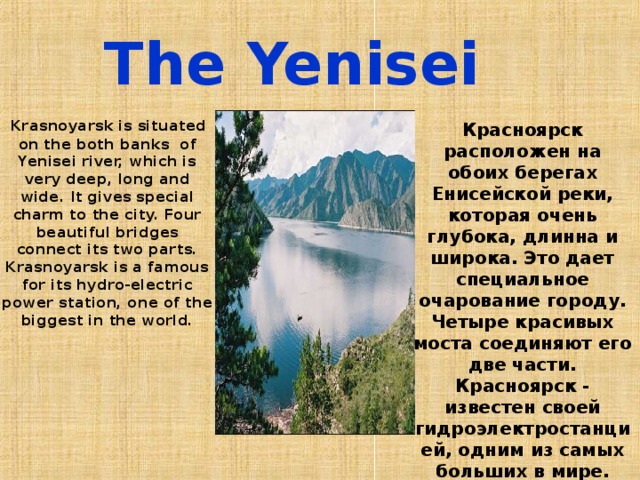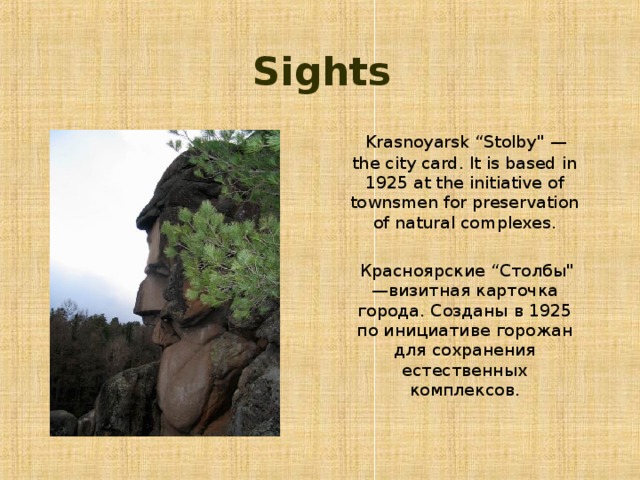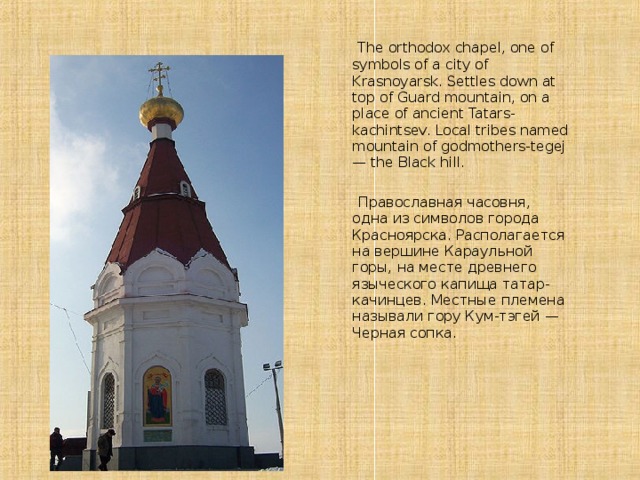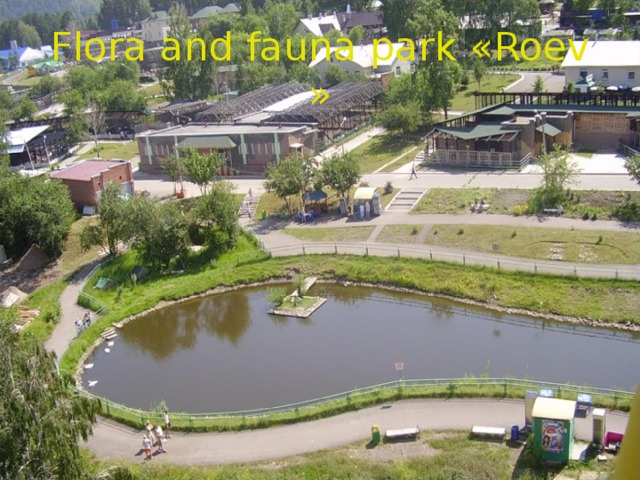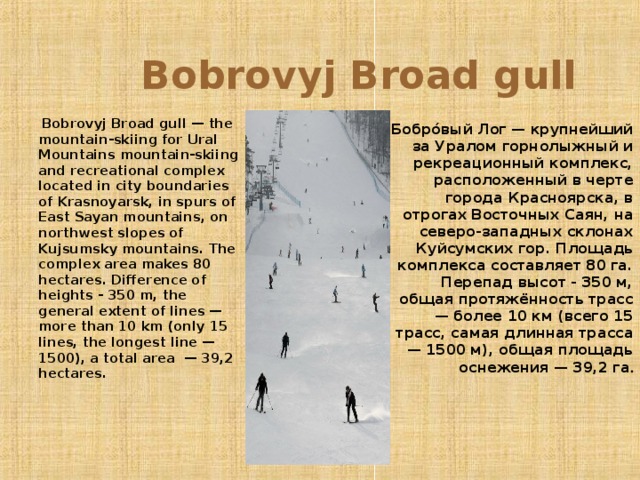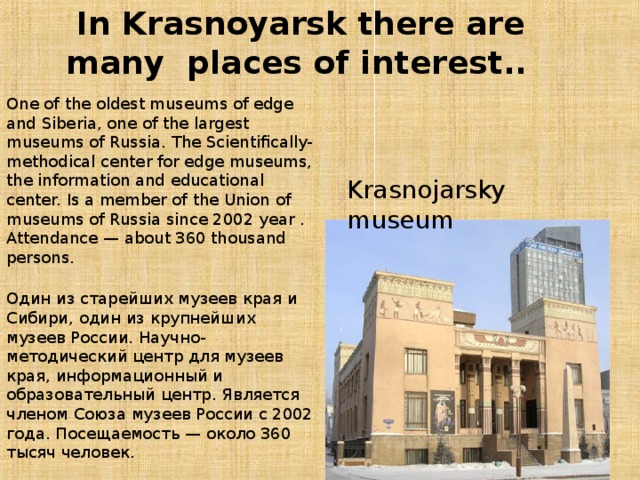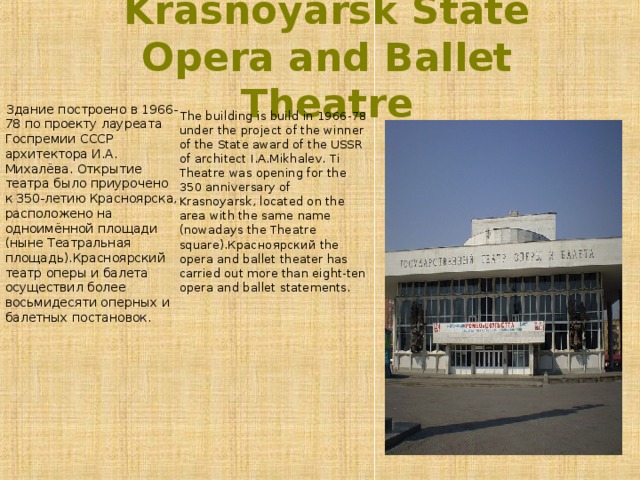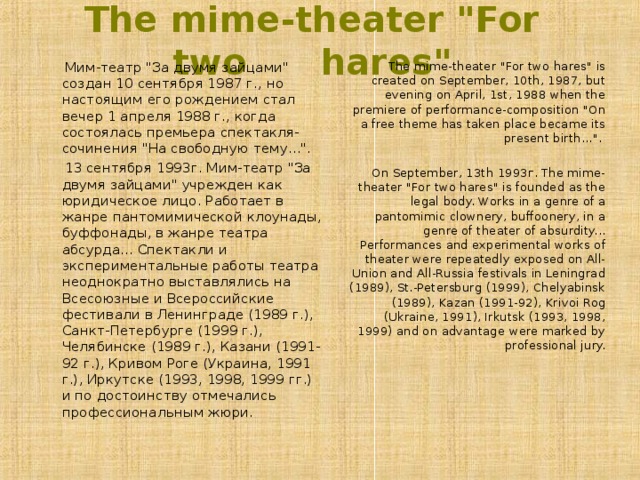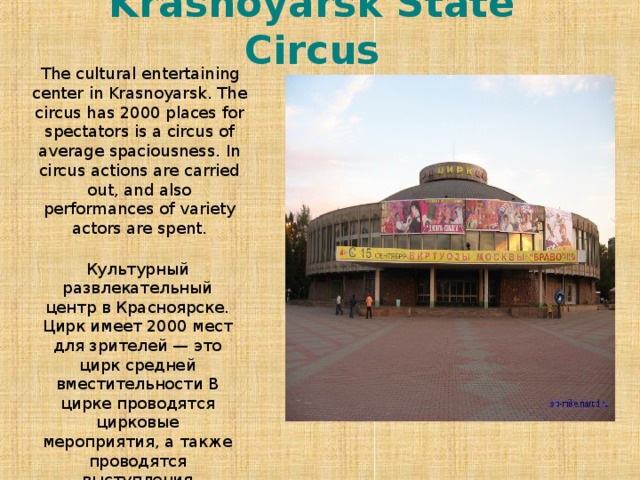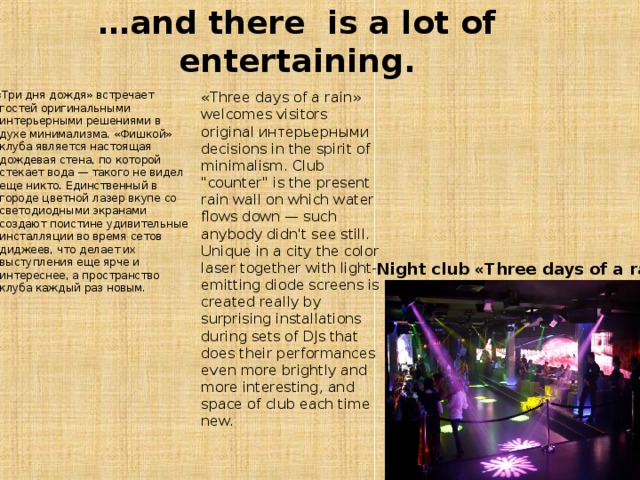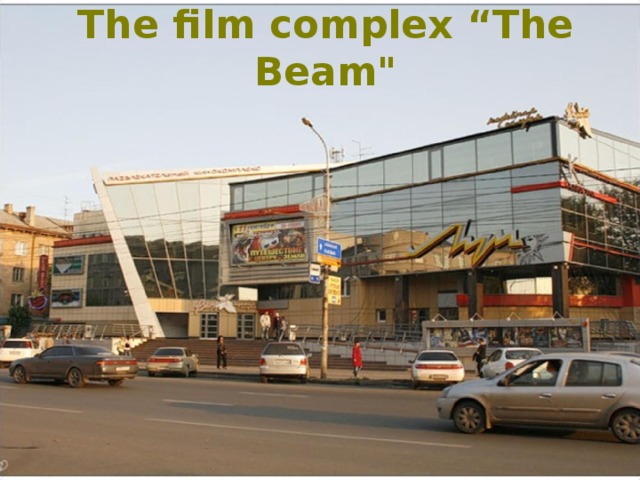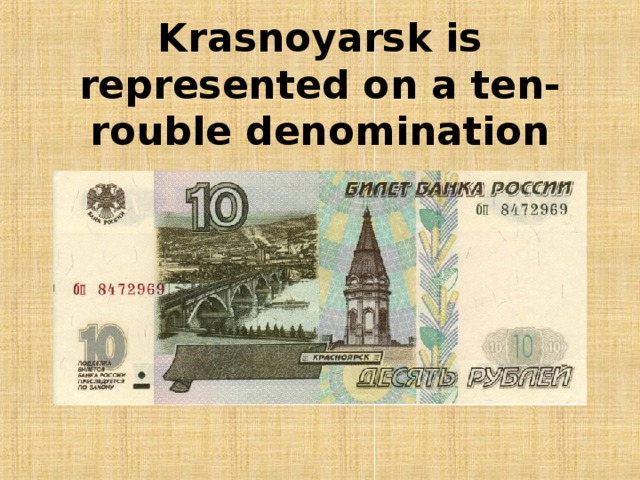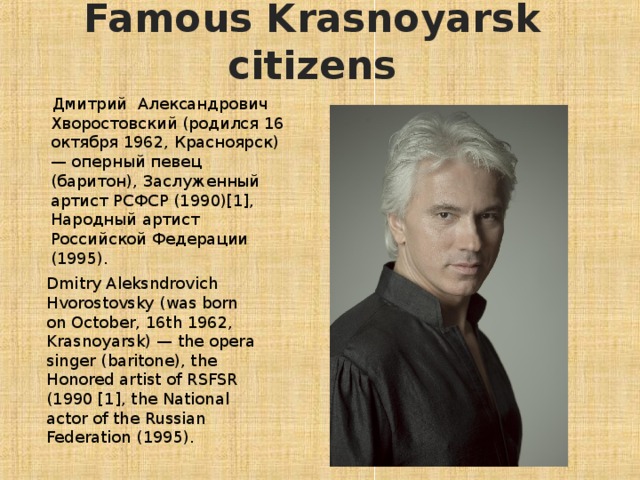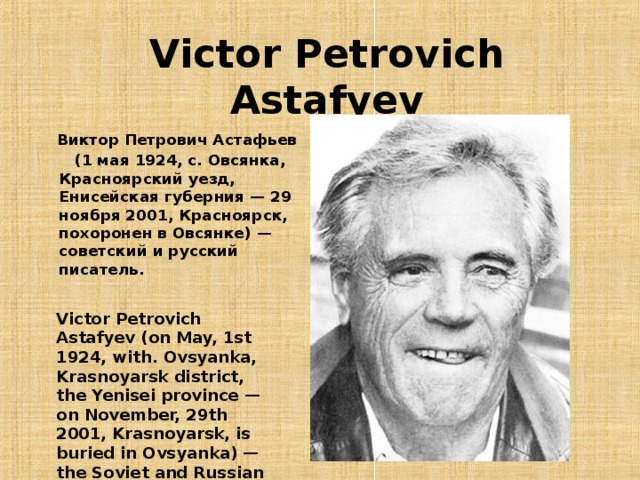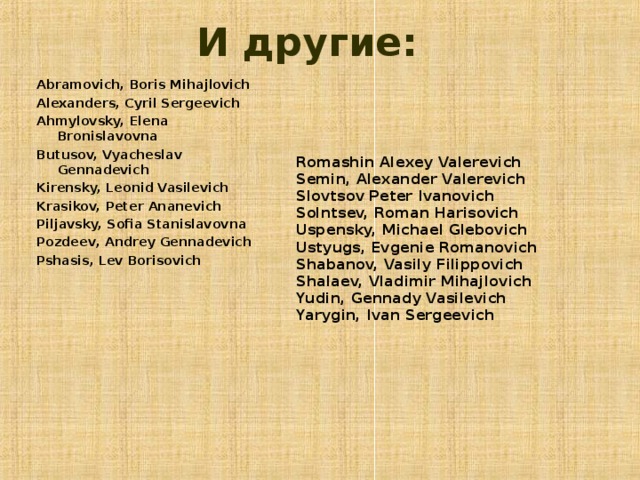Krasnoyarsk Stolby
Published on May 18, 2013, updated on Jun 7, 2019
In today’s series “Read and listen in Russian” designed for your Russian reading and listening practice we’d like to tell you about a wondeful place – a National Nature Reserve Krasnoyarsk Stolby. “Stolby” is the plural of “stolb”, the Russian for “pillar”. The regular Stolby goers call themselves “stolbists”, and the public activity as a whole is called “stolbism”. It is an exceptional activity with a long history of over 150 years and old customs recorded in a special folklore.
You’ll see some gorgeous photos and learn about this Nature Reserve and how to get there (in case one day you find yourself around that area).
The lesson is accompanied by an audio file recorded by a native Russian speaker.
Красноя́рск явля́ется са́мым кру́пным городoм Восто́чной Сиби́ри и Да́льнего Восто́ка. Он был постро́ен казака́ми в 1628 году, и в настоя́щий моме́нт насчи́тывает 980 ты́сяч челове́к населе́ния. Но в бо́льшей сте́пени Красноя́рск изве́стен в ми́ре благодаря́ приро́дному запове́днику “Красноя́рские столбы́”.
Krasnoyarsk is the largest city in Eastern Siberia and the Far East. It was built by the Cossacks in 1628, and currently has 980,000 inhabitants. But Krasnoyarsk is mostly worldwide known due to the nature reserve “Krasnoyarsk Pillars.”
Красноя́рские Столбы́ – уника́льное явле́ние. О них напи́сано мно́го книг, стате́й, стихо́в, пе́сен. О них снима́ются фи́льмы и они́ слу́жат исто́чником вдохнове́ния худо́жников. Со Столба́ми свя́зано мно́жество су́деб и собы́тий. Там роди́лось и живёт уника́льное движе́ние “столбистов”, со свои́ми тради́циями и своеобра́зным фолькло́ром.
Krasnoyarsk Columns is a unique phenomenon. It is written a lot of books, articles, poems, and songs about it. The movies are made about it and they are the source of inspiration of artists. Many lives and events are connected to it. A unique move of “stolbistov” was born and still alive there with its own traditions and unique folklore.
Есть непосре́дственно «Столбы́» — откры́тые для тури́стов ска́лы, и «Ди́кие столбы́» — скалы́, располо́женные в глубине́ запове́дника, до́ступ к кото́рым ограни́чен. На одно́м столбе́ одновреме́нно мо́жет быть о́чень мно́го люде́й, так что здесь быва́ют са́мые настоя́щие про́бки. К сожале́нию, со столбо́в дово́льно ча́сто срыва́ются и ги́бнут лю́ди, т.к. большинство́ ле́зут на них без страхо́вки, а лете́ть вниз не оди́н деся́ток ме́тров.
There are just “Columns” – open for tourists rocks, and “Wild columns” – rocks located in the depths of the reserve, access to which is restricted. In one column at a time can be a lot of people, so there happens real ‘traffic jams’ there. Unfortunately, very often people fall down from the columns and die because most of them climb there without safety equipment and it’s more than a dozen meters to fly down.
Почти́ все ска́лы запове́дника име́ют имена́. Поимено́ваны та́кже не́которые отде́льные ка́мни и фрагме́нты (ча́сти) скал. Ска́лы мо́гут быть одино́чными и́ли образо́вывать гру́ппы. На ска́лах проло́жены ходы́, кото́рые, как пра́вило, веду́т к верши́нам. Осо́бое ме́сто на скале́, прохожде́ние кото́рого тре́бует осо́бого мастерства́, называ́ется “хитрушка”.
Almost all rocks of the reserve have names. Also some of the individual stones and fragments (part) of the rocks are named. Rocks can be solitary or to form groups. On the rocks laid moves that tend to lead to the top. A special place on the rock, the passage of which requires special skills, is called “hitrushka.”
Спорти́вные тра́ссы на ска́лах испо́льзуются спортсме́нами для трениро́вок и соревнова́ний. Тра́ссы э́ти прохо́дятся то́лько с примене́нием снаряже́ния и страхо́вки. На ска́лах запове́дника бы́ло воспи́тано мно́жество выдаю́щихся скалола́зов и альпини́стов.
Sport routes on cliffs are used by athletes for training and competition. These routes are traversed only with the use of equipment and safety equipment. On the cliffs of the reserve had been raised many outstanding rock climbers and mountaineers.
На террито́рии запове́дника обита́ют 56 ви́дов млекопита́ющих и и произраста́ют 762 ви́да расте́ний, 150 из кото́рых подлежа́т осо́бой охра́не. Из кру́пных и сре́дних хи́щников в запове́днике встреча́ются: бу́рый медве́дь, волк, рысь, росома́ха, лиси́ца, барсу́к. Из копы́тных ши́ре други́х в запове́днике распространён мара́л – са́мый кру́пный подви́д благоро́дного оле́ня. Есть косу́ли и ло́си. Там же мо́жно встре́тить бе́лку-летя́гу и́ли лету́чих мыше́й. Са́мым распространённым расте́нием явля́ется пи́хта.
On the area of the the reserve 56 species of mammals live and 762 species of plants grow, 150 of which are subject to special protection. Among large and medium-sized predators in the reserve live: the brown bear, wolf, lynx, wolverine, fox, badger. Among ungulates more common is siberian stag – the largest subspecies of red deer. There are roes and elks. There you can find a flying squirrel or a bat. The most common plant is fir.
В запове́днике отме́чено о́коло 400 ви́дов насеко́мых. Одно́ из них – таёжный клещ, явля́ется перено́счиком опа́сного для люде́й заболева́ния – клещево́го энцефали́та. Пе́рвые акти́вные клещи́ появля́ются весно́й, как то́лько земля́ освобожда́ется от сне́жного покро́ва. Максима́льная акти́вность клеще́й обы́чно наблюда́ется в конце́ ма́я – нача́ле ию́ня. В ию́ле наступа́ет спад их акти́вности, а в а́вгусте встреча́ются то́лько едини́чные экземпля́ры. Поэ́тому посеща́я запове́дник ну́жно быть о́чень внима́тельным и регуля́рно осма́тривать себя́ и попу́тчиков на нали́чие клеще́й.
In the reserve about 400 species of insects are noted. One of them is the taiga tick – a carrier of a dangerous disease for people – tick-borne encephalitis. First active mites appear in the spring as the earth free from snow. The maximum activity of ticks usually occurs in late May or early June. In July comes the decline in their activity, and in August, there are only isolated instances. Therefore visiting reserve you must be very careful and regularly inspect yourself and travel companions for the presence of ticks.
Террито́рия запове́дника «Столбы́» вплотну́ю грани́чит с го́родом Красноя́рск, поэ́тому у тури́стов ча́ще всего́ не возника́ет пробле́м с прожива́нием: в го́роде доста́точно гости́ниц, где мо́жно останови́ться на ночле́г. Добра́ться из го́рода практи́чески до террито́рии запове́дника мо́жно на городско́м тра́нспорте (он не доезжа́ет до запове́дной грани́цы всего́ 2 км). Э́то расстоя́ние посети́тели обы́чно преодолева́ют пешко́м и́ли в выходны́е дни по́льзуются авто́бусом запове́дника, кото́рый доставля́ет их непосре́дственно в запове́дник.
The area of the reserve “Stolby” closely borders the city of Krasnoyarsk, so tourists usually do not have problems with accommodation: there are enough hotels in the city where you can stay for the night. To get out of the city to the reserve you can by public transport (he doesn’t reach the boundary of the reserve only 2 km). This distance visitors usually pass on foot or use the reserve’s bus on weekends, which delivers them directly to the reserve.
Переночева́ть в само́м запове́днике «Столбы́» мо́жно в пала́точном ла́гере, кото́рый рабо́тает с ма́я до конца́ ле́та. Тури́стам предоставля́ются электри́чество, дрова́, га́зовая печь, туале́т, поддо́н под пала́тку. Но в э́том слу́чае необходи́мо зара́нее отпра́вить зая́вку.
To stay overnight in the reserve “Stolby” you can in a camp, which runs from May to the end of summer. Tourists have electricity, firewood, gas oven, toilet, and a pallet under the tent. But in this case, you must send a request in advance.
Krasnoyarsk city, Russia
Krasnoyarsk is one of the largest cities in Russia, the largest cultural, educational, economic, and industrial center of Eastern Siberia, the administrative center of Krasnoyarsk Krai (the second largest subject of the Russian Federation).
Krasnoyarsk city flag
Krasnoyarsk city coat of arms
Krasnoyarsk city map, Russia
Krasnoyarsk city latest news and posts from our blog:
History of Krasnoyarsk
Foundation of Krasnoyarsk
Krasnoyarsk is one of the oldest cities in Siberia. People began to settle in the territory of Krasnoyarsk from the Upper Paleolithic era (about 28-32 thousand years ago). Before the arrival of the Russians, it was part of the Yezher Principality of the Yenisei Kyrgyz.
This area became known to the Russians in 1608, when the Cossacks went up the Yenisei River with the intention of finding new lands and annexing them to the possessions of the Moscow Tsar. Local tribes refused to pay yasak (tribute) to the Russians and bothered them with raids. Therefore, the Cossacks decided to turn to the Yenisei voivode with a request for help and protection.
The Yenisei voivode Yakov Khripunov sent a nobleman Andrei Dubensky to inspect the land occupied by the Cossacks and find a place to build a fortified settlement. Dubensky found it at the confluence of the Kacha River into the Yenisei, made a plan, and with it went to Moscow. The presented plan was approved and he was allowed to proceed with the construction of the settlement.
At the end of 1627, after returning from Moscow, Dubensky with three hundred Cossacks left Yeniseisk to found a new fortified settlement. On August 19, 1628, the construction of a small fort called “Krasnyy Yar” (literally meaning “red steep bank”) was completed below Krasnoyarsk, opposite Tatyshev Island. It was named after the red color of marl of the left high bank of the Kacha River. This day is considered the day of foundation of Krasnoyarsk.
Initially, the most important function of the fort was the defense of the main Russian settlements of Siberia from the south. The Yenisei Kyrgyz and tribes subordinate to them repeatedly attacked the fort of Krasnyy Yar and the villages located next to it. The most devastating raids were in 1630, 1634, 1635, 1636, 1640, 1665, 1667, and 1679.
Krasnoyarsk in the 18th-19th centuries
In 1708, the population of Krasnoyarsk was 849 people. In 1713, 1,295 men and 1,217 women lived in it. After the defeat of the Yenisei Kyrgyz, the departure of their princes to the foothills of the Tien Shan, the construction of the Abakan and Sayan forts, and the signing of the Kyakhta peace with Manchuria in 1728, Krasnoyarsk lost its strategic importance as a military outpost.
In 1733-1734, Vitus Jonassen Bering, a Danish cartographer and explorer in Russian service, lived in Krasnoyarsk procuring provisions and equipment for his expedition. The gradual growth of Krasnoyarsk began, when the Siberian Route reached it in 1735 (the federal highway R255 “Siberia”). This road connected Krasnoyarsk with Achinsk, Kansk, and other parts of the Russian Empire.
In 1772, the population of Krasnoyarsk was only about 2 thousand people, it remained a small district town. In 1734-1743, the German natural scientist and traveler Johann Georg Gmelin lived and worked in Krasnoyarsk. In 1756, an ironworks was founded near the town.
In 1771-1773, the famous Prussian zoologist and botanist Peter Simon Pallas visited Krasnoyarsk three times. Here he discovered a 680-kilogram meteorite fragment named “Krasnojarsk”. It was the first meteorite discovered in Russia and the first pallasite meteorite ever found.
After the fire of 1773, there were only thirty houses left in Krasnoyarsk. The geodesy sergeant Pyotr Moiseev was sent to Krasnoyarsk from Tobolsk to draw up a new linear layout for the town on the model of St. Petersburg. This became the beginning of today’s Krasnoyarsk.
The life of the town changed when the Yenisei Governorate was created in 1822. Krasnoyarsk was chosen as its center. It was not the largest town in the region, but it occupied the most favorable economic and geographical position. The town was one of the places of political exile. Eight Decembrists were exiled to Krasnoyarsk after the suppression of the 1825 uprising.
In 1834, a town garden (present Central Park) was laid out in Krasnoyarsk. In 1846, a public library was opened. In 1856, the population of Krasnoyarsk was about 6,400 people. In 1863, shipping began along the Yenisei. At the same time, a telegraph station began operating in the town. In 1889, the town public museum was opened in Krasnoyarsk, as well as the first medical assistant school in Siberia.
In 1894, the first technical railway school in Siberia was opened in Krasnoyarsk. Further growth of the town was connected with the discovery of gold in the region and the advent of the railway in 1895. The supply of rails for the construction of the Trans-Siberian Railway was carried out by the Northern Sea Route. In 1897, the population of Krasnoyarsk was about 26,700 people.
Krasnoyarsk in the 20th century and beyond
In 1908, the first stationary movie theater was opened in Krasnoyarsk. In 1912, the first power station was commissioned. In 1913, the first city water supply system was built. In September 1913, the Norwegian explorer Fridtjof Nansen stayed in Krasnoyarsk making a trip to Eastern Siberia and the Far East. His goal was to establish permanent trade relations with Central Siberia by sea through the Kara Sea and the Yenisei River.
During the First World War, one of the largest prisoners of war camps in the Russian Empire was organized in Krasnoyarsk. By the end of 1915, there were about 13 thousand prisoners of war in it. In 1920, Maria Bochkareva, the creator of the first women’s battalion in the history of the Russian army, was sentenced to death in Krasnoyarsk because of her active involvement in the fight against the Bolsheviks. In 1923, the population of Krasnoyarsk was 59,258 people.
In 1934, Krasnoyarsk became the administrative center of Krasnoyarsk Krai. In 1939, there were 189,977 residents in this city. By the beginning of 1941, about 39,000 people worked at all industrial enterprises of Krasnoyarsk.
During the Second World War, a number of factories from European Russia were evacuated to the city. The Alsib (Alaska-Siberia) air route passed through Krasnoyarsk. It was used as a stop by military aircraft sent from the USA and the aircraft factories of Irkutsk, Ulan-Ude, Komsomolsk-on-Amur. During the war years, the industrial power of Krasnoyarsk increased by 7 times. It became the main industrial center of Eastern Siberia.
The development of the hydropower resources of the Angara and the Yenisei, which began in the postwar years, became a new page in the history of Krasnoyarsk. During this period of industrial growth, not only a powerful electric power industry was created, but also large enterprises of the ferrous and non-ferrous metallurgy, pulp and paper, medical and chemical industries were built.
Krasnoyarsk also became a major center of academic science, higher and secondary specialized education. In 1989, the population of Krasnoyarsk was about 912,000 people. After the collapse of the USSR, the city experienced depopulation, its population decreased by about 10%. However, at the end of the 20th century, the population of the city again began to constantly grow.
In 1995, the construction of the Krasnoyarsk metro was started. Several times the construction was stopped due to lack of funds. It is planned that the metro will be open in the mid-2020s.
In 2006, the first of the Russian federal universities, the Siberian Federal University, was established in this city. In 2012, Krasnoyarsk became the 14th city in Russia with a population of more than 1 million people. In 2019, the XXIX World Winter Universiade 2019 was held in the city.
Streets of Krasnoyarsk
Street traffic in Krasnoyarsk
Author: Oscar Ballesteros
On the street in Krasnoyarsk
Author: Andrey Pivovarov
Embankment along the Yenisei River in Krasnoyarsk
Author: Dmitry Antipov
Krasnoyarsk, located in the forest-steppe zone and in mountainous areas on both banks of the Yenisei River in central Russia, is unofficially called the capital of Siberia. Founded in 1628, it is the largest of the old cities of Siberia. Krasnoyarsk is the easternmost city with a population of more than 1 million people in Russia.
Krasnoyarsk is a developed center of industry in Russia. On the territory of the city there are more than 17,000 enterprises, organizations, institutions. The leading industries are space industry, non-ferrous metallurgy, mechanical engineering, woodworking, transportation, chemical, food, retail and wholesale, services.
The international airport of Krasnoyarsk offers regular flights to Vladivostok, Irkutsk, Kazan, Krasnodar, Moscow, Novosibirsk, Norilsk, St. Petersburg, Sochi, Surgut, Tomsk, Khabarovsk, Chelyabinsk, Chita, Yakutsk, and a number of other cities.
Krasnoyarsk is also a large scientific, educational, and sports center of Russia. At the Siberian Federal University alone, over 40,000 students are studying. In total, there are more than 150,000 students in the city.
The design of the Russian 10 ruble banknote is dedicated to Krasnoyarsk. On it you can see the Paraskeva Pyatnitsa Chapel, the Communal Bridge, and the Krasnoyarsk Hydroelectric Power Station. Today, these banknotes are almost completely withdrawn from circulation.
Main Attractions of Krasnoyarsk
The exposition reflects the history of this huge region from ancient times to the present. Here you can see archaeological, paleontological, art, ethnographic, natural science collections of world significance. Dubrovinskogo Street, 84.
Literary Museum named after V.P. Astafyev. The museum collection is housed in a picturesque 19th-century mansion built of wood in the Art Nouveau style with Gothic motifs. Today, this building is an architectural monument of federal significance, one of the most beautiful buildings in Krasnoyarsk. Lenina Street, 66.
Krasnoyarsk city of Russia photos
Sights of Krasnoyarsk
Fountain and the Krasnoyarsk Big Ben
Sights of Krasnoyarsk — Достопримечательности Красноярска

Krasnoyarsk, which is the most eastern of Russian millionaires, is capable of capturing the imagination of even a seasoned traveler. And itӳ not even the case that, being founded in 1628, it has a rich history. With its beauty, unpredictability, modernity, the metropolis destroys traditional stereotypes about the provinciality of Siberia. Do you think that fountains and palm trees are attributes of southern resorts? Come to Krasnoyarsk and see how deeply you were wrong! Sights of Krasnoyarsk, photos, and descriptions of which you will find in the article — this is just not much of what is worth seeing here. The city will amaze and charm you, making you fall in love with yourself.
The Krasnoyarsk pillars are a state natural reserve located in the spurs of the Eastern Sayans, on the right bank of the Yenisei. Local cliffs are called pillars because of their shape. The age of the pillars is worthy of respect: according to various sources, 450 to 600 million years have passed since the day they appeared.
Walking through the center of Krasnoyarsk, along with the Yenisei embankment, you cannot fail to notice the artsy building behind the Communal bridge, similar to an Egyptian temple. Come in — this is a regional museum of local lore. The architecture and ornament of the museum are explained by the dream of its author, the famous city architect L. Chernyshev.
There is an unusual-looking house in Krasnoyarsk, you will see — it is immediately clear: it is an architectural monument. And the oddity to it is given by the combination of wooden modern with the Gothic style — carved lace of a tree and a spire with arches. This 19th-century mansion was owned by merchant Frieda Zuckerman.
At 30 km from Krasnoyarsk, there is a viewing platform with the monument to Tsar-Ryby, the story of the same name by Viktor Astafyev. An incredible view of the Yenisei opens from a multimeter cliff, on the left bank of which, clearly, is Ovsyanka, an ancient Siberian village, the writer’s birthplace.
The city of fountains, the theater city, the city on the Yenisei, the capital of Siberia … It’s all about Krasnoyarsk! And although the people of Novosibirsk are very jealous, when the former Krasnoyarsk jail is called the capital of the region, the locals have no doubt about this fact and are even more fierce than they are. Recently, namely from April 2012, Krasnoyarsk is a million-plus city, the 14th in Russia in a row. And in 2019, the 19th World Winter Universiade will be held here.
Презентация на тему:»Wellcome to Krasnoyarsk».
Презентация на тему:»Wellcome to Krasnoyarsk».
Krasnoyarsk is one of the largest and most beautiful cities of Siberia. It was founded by Andrei Dubensky in 1628 as a fortress against the attacks of the native tribes. Now Krasnoyarsk is one of the leading centers of modern industry, science, education and culture, the capital of the Krasnoyarsk Krai, its economic, political and administrative centre. The population of the city is about a million people.
Просмотр содержимого документа
«Презентация на тему:»Wellcome to Krasnoyarsk». »

The symbols of Krasnoyarsk
Krasnoyarsk is one of the largest and most beautiful cities of Siberia. It was founded by Andrei Dubensky in 1628 as a fortress against the attacks of the native tribes. Now Krasnoyarsk is one of the leading centers of modern industry, science, education and culture, the capital of the Krasnoyarsk Krai, its economic, political and administrative centre. The population of the city is about a million people.
Andrey Dubensky was the first who has chosen a place for building of a jail, the future million Krasnoyarsk, the founder.
On the instructions of Yenisei Jacob Hripunova has gone Dubensky of Yeniseisk upwards across Yenisei to choose a place for a bookmark of the new jail providing safety of Yeniseisk, Tomsk and Kuznetsk, places already rendered habitable and important for Moscow.

The weather is warm, sunny and cloudy
Krasnoyarsk is administratively divided into 7 districts:
Sverdlovsk District (it is founded on March, 23rd, 1977 (is allocated from the Kirov area))
Soviet District (it is founded on May, 29th, 1969 (is allocated from the Central area)
Central District (the Stalin area is founded on June, 25th, 1938. It is renamed on November, 5th, 1961)
На данный момент в городе проживает 972,8 тысяч человек.
Krasnoyarsk is situated on the both banks of Yenisei river, which is very deep, long and wide. It gives special charm to the city. Four beautiful bridges connect its two parts. Krasnoyarsk is a famous for its hydro-electric power station, one of the biggest in the world.
Krasnoyarsk “Stolby» — the city card. It is based in 1925 at the initiative of townsmen for preservation of natural complexes.
Красноярские “Столбы» —визитная карточка города. Созданы в 1925 по инициативе горожан для сохранения естественных комплексов.
The orthodox chapel, one of symbols of a city of Krasnoyarsk. Settles down at top of Guard mountain, on a place of ancient Tatars-kachintsev. Local tribes named mountain of godmothers-tegej — the Black hill.
Православная часовня, одна из символов города Красноярска. Располагается на вершине Караульной горы, на месте древнего языческого капища татар-качинцев. Местные племена называли гору Кум-тэгей — Черная сопка.
The railway bridge through the river Yenisei
The railway bridge through the river Yenisei
Length of the bridge of 1 km, width of flights to 140 meters, height of metal farms in top of a parabola of 20 meters.
The bridge has been built by Russian workers and technicians under the direction of engineer Evgenie Karlovicha Knorre under the project of the professor of Imperial Moscow Technical School of Laurels Proskurjakova. Building is begun in 1895. It has been finished on March, 28th, 1899. Bridge tests on March, 27th have taken place
Длина моста 1 км, ширина пролётов до 140 метров, высота металлических ферм в вершине параболы 20 метров.
Мост был сооружён русскими рабочими и техниками под руководством инженера Евгения Карловича Кнорре по проекту профессора Императорского Московского Технического Училища Лавра Проскурякова. Строительство начато в 1895 году. Было завершено 28 марта 1899 года. 27 марта состоялись испытания моста
Flora and fauna park «Roev »
Flora and fauna park «Roev »
One of the largest zoos of Russia. The name to a zoo has been appropriated following the results of city competition by name a stream proceeding nearby (Roev— from a word to «dig»: in a XIX-th century on a stream washed / dug / gold). The park Total area makes 31 hectares, the park continues to develop. 270 kinds from a collection «Roeva of a stream» — in the International Red book; 33 kinds — in the Red book of the Russian Federation. In zoo territory 460 kinds and grades of plants
Один из крупнейших зоопарков России. Название зоопарку было присвоено по итогам городского конкурса по имени ручья, протекающего рядом (роев — от слова «рыть»: в XIX веке по ручью мыли /рыли/ золото). Общая площадь парка составляет 31 га, парк продолжает развиваться. 270 видов из коллекции «Роева ручья» — в Международной Красной книге; 33 вида — в Красной книге Российской Федерации. На территории зоопарка 460 видов и сортов растений
Bobrovyj Broad gull
In Krasnoyarsk there are many places of interest ..
Один из старейших музеев края и Сибири, один из крупнейших музеев России. Научно-методический центр для музеев края, информационный и образовательный центр. Является членом Союза музеев России с 2002 года. Посещаемость — около 360 тысяч человек.
Krasnoyarsk State Opera and Ballet Theatre
Здание построено в 1966-78 по проекту лауреата Госпремии СССР архитектора И.А. Михалёва. Открытие театра было приурочено к 350-летию Красноярска, расположено на одноимённой площади (ныне Театральная площадь).Красноярский театр оперы и балета осуществил более восьмидесяти оперных и балетных постановок.
The building is build in 1966-78 under the project of the winner of the State award of the USSR of architect I.A.Mikhalev. Ti Theatre was opening for the 350 anniversary of Krasnoyarsk, located on the area with the same name (nowadays the Theatre square).Красноярский the opera and ballet theater has carried out more than eight-ten opera and ballet statements.
The mime-theater «For two hares»
The mime-theater «For two hares» is created on September, 10th, 1987, but evening on April, 1st, 1988 when the premiere of performance-composition «On a free theme has taken place became its present birth. «.
On September, 13th 1993г. The mime-theater «For two hares» is founded as the legal body. Works in a genre of a pantomimic clownery, buffoonery, in a genre of theater of absurdity. Performances and experimental works of theater were repeatedly exposed on All-Union and All-Russia festivals in Leningrad (1989), St.-Petersburg (1999), Chelyabinsk (1989), Kazan (1991-92), Krivoi Rog (Ukraine, 1991), Irkutsk (1993, 1998, 1999) and on advantage were marked by professional jury.
Мим-театр «За двумя зайцами» создан 10 сентября 1987 г., но настоящим его рождением стал вечер 1 апреля 1988 г., когда состоялась премьера спектакля-сочинения «На свободную тему. «.
13 сентября 1993г. Мим-театр «За двумя зайцами» учрежден как юридическое лицо. Работает в жанре пантомимической клоунады, буффонады, в жанре театра абсурда. Спектакли и экспериментальные работы театра неоднократно выставлялись на Всесоюзные и Всероссийские фестивали в Ленинграде (1989 г.), Санкт-Петербурге (1999 г.), Челябинске (1989 г.), Казани (1991-92 г.), Кривом Роге (Украина, 1991 г.), Иркутске (1993, 1998, 1999 гг.) и по достоинству отмечались профессиональным жюри.
Krasnoyarsk State Circus
The cultural entertaining center in Krasnoyarsk. The circus has 2000 places for spectators is a circus of average spaciousness. In circus actions are carried out, and also performances of variety actors are spent.
Культурный развлекательный центр в Красноярске. Цирк имеет 2000 мест для зрителей — это цирк средней вместительности В цирке проводятся цирковые мероприятия, а также проводятся выступления эстрадных артистов.
«Three days of a rain» welcomes visitors original интерьерными decisions in the spirit of minimalism. Club «counter» is the present rain wall on which water flows down — such anybody didn’t see still. Unique in a city the color laser together with light-emitting diode screens is created really by surprising installations during sets of DJs that does their performances even more brightly and more interesting, and space of club each time new.
«Три дня дождя» встречает гостей оригинальными интерьерными решениями в духе минимализма. «Фишкой» клуба является настоящая дождевая стена, по которой стекает вода — такого не видел еще никто. Единственный в городе цветной лазер вкупе со светодиодными экранами создают поистине удивительные инсталляции во время сетов диджеев, что делает их выступления еще ярче и интереснее, а пространство клуба каждый раз новым.
Night club «Three days of a rain»
The film complex “The Beam»
The film complex “The Beam»
Кинокомплекс «Луч», расположенный на 5-ти уровнях, не только 4 зала в кинотеатре на 1000 мест, но и развлекательным центром с обширной инфраструктурой.
Ежедневно «Луч» посещают от 5 до 15 тыс. человек. Самый большой киноэкран в Красноярске, удобное расположение в центре города с автобусной остановкой на крыльце, возможность купить кинобилеты в любом районе города через терминалы «Платежка», Wi-Fi свободный доступ в Интернет, Bluetooth-зона и другие отличительные особенности, сделали развлекательный кинокомплекс «Луч» самым излюбленным местом отдыха красноярцев.
Film complex «the Beam» located at 5 levels, not only 4 halls at a cinema on 1000 places, but also the entertaining center with an extensive infrastructure.
Daily «Beam» visit from 5 to 15 thousand persons. The biggest screen in Krasnoyarsk, a convenient arrangement in city center with a bus stop on a porch, possibility to buy film tickets in any disctrict of the city through terminals «Pay-sheets», Wi-Fi an easy approach in the Internet, the Bluetooth-zone and other distinctive features, have made an entertaining film complex «Beam» the most favourite vacation spot of Krasnoyarsk citizens.
Krasnoyarsk is represented on a ten-rouble denomination
Famous Krasnoyarsk citizens
Дмитрий Александрович Хворостовский (родился 16 октября 1962, Красноярск) — оперный певец (баритон), Заслуженный артист РСФСР (1990)[1], Народный артист Российской Федерации (1995).
Dmitry Aleksndrovich Hvorostovsky (was born on October, 16th 1962, Krasnoyarsk) — the opera singer (baritone), the Honored artist of RSFSR (1990 [1], the National actor of the Russian Federation (1995).
Victor Petrovich Astafyev
Виктор Петрович Астафьев (1 мая 1924, с. Овсянка, Красноярский уезд, Енисейская губерния — 29 ноября 2001, Красноярск, похоронен в Овсянке) — советский и русский писатель.
Victor Petrovich Astafyev (on May, 1st 1924, with. Ovsyanka, Krasnoyarsk district, the Yenisei province — on November, 29th 2001, Krasnoyarsk, is buried in Ovsyanka) — the Soviet and Russian writer.
Vasily Ivanovich Surikov
Василий Иванович Суриков (24 января 1848, Красноярск — 19 марта 1916, Москва) — великий русский живописец, мастер масштабных исторических полотен.
Vasily Ivanovich Surikov (on January, 24th 1848, Krasnoyarsk — on March, 19th 1916, Moscow) — the great Russian painter, the master of scale historical cloths.
Абрамович, Борис Михайлович
Александров, Кирилл Сергеевич
Ахмыловская, Елена Брониславовна
Бутусов, Вячеслав Геннадьевич
Киренский, Леонид Васильевич
Красиков, Пётр Ананьевич
Пилявская, Софья Станиславовна
Поздеев, Андрей Геннадьевич
Псахис, Лев Борисович
Ромашин Алексей Валерьевич
Сёмин, Александр Валерьевич
Словцов Пётр Иванович
Солнцев, Роман Харисович
Успенский, Михаил Глебович
Устюгов, Евгений Романович
Шабанов, Василий Филиппович
Шалаев, Владимир Михайлович
Юдин, Геннадий Васильевич
Ярыгин, Иван Сергеевич
Abramovich, Boris Mihajlovich
Alexanders, Cyril Sergeevich
Ahmylovsky, Elena Bronislavovna
Butusov, Vyacheslav Gennadevich
Kirensky, Leonid Vasilevich
Krasikov, Peter Ananevich
Piljavsky, Sofia Stanislavovna
Pozdeev , Andrey Gennadevich


